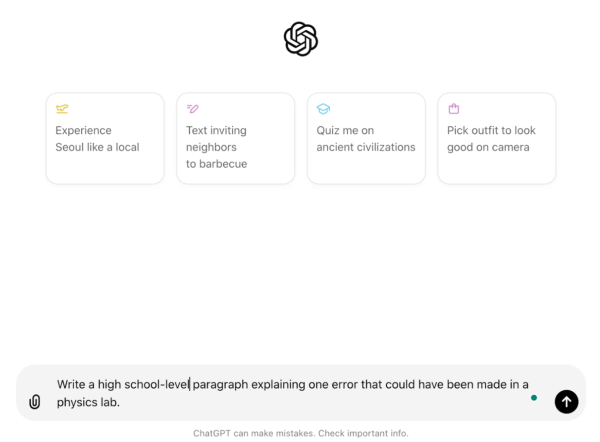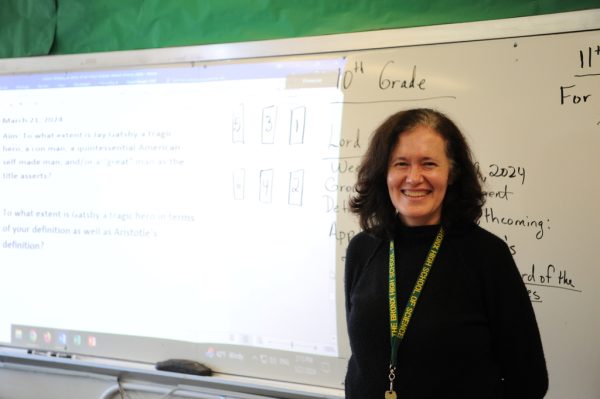“Write a high school level paragraph explaining one error that could have been made in a physics lab.” That was the command that I gave to Chat GPT. Within seconds, it spawned an explanation, ready to be copied and pasted.
Chat GPT took the world by storm a year and a half ago when the chatbot was released for public use on November 30th, 2022. It has been an earthquake, shaking the foundations of the modern school system and leaving many teachers panicked and unsure how to proceed with the methods of teaching used for decades.
With the popularity and unlimited accessibility of Chat GPT, many teachers fear that some students will heavily rely on AI to write essays, complete homework assignments, and other school work. In light of this fear, I decided to test if teachers can recognize artificial intelligence in student work. I developed a simple test, creating two paragraphs, one written by a student and the other by Chat GPT.
I compiled a total of six paragraphs, two for English, two for history, and two for physics. One paragraph in each subject was written by a student, and the other paragraph in each subject was written by Chat GPT. I gave five teachers at Bronx Science these paragraphs and asked them to determine which one, for all three subjects, was written by a student and which one was written by Chat GPT.

Testing Teachers
A variety of AI-identifying quizzes have been developed during the past 18 months to test if experts and average adults in the field can tell the difference between “real,” or student-written and “fake,” or AI writing. The New York Times developed an online quiz available online for anyone to take. Instead of high school-level writing, it uses fourth-grade writing samples and prompts describing recess and writing a fictional story about a castle. Teachers and professionals sifted through written work to determine which pieces are real versus fake. The test was administered to teachers, writing experts, and even Judy Blume, famous for her best-selling book, Tales of a Fourth-Grade Nothing.
The high school-level quiz that I designed was administered to five Bronx Science teachers; three correctly identified the history paragraph, and two correctly identified the English and physics paragraphs.
Mr. Richard Lee, a biology and research teacher who has been teaching Bronx Science for over 30 years, more than any other faculty member, got every question right on the test. He also took the least time to differentiate between student and AI responses. He said that the ones written by Chat GPT, for the most part, were better constructed, more logically organized, and more eloquent, but, after reading student research papers for several years, he knew that type of writing wasn’t common among students.
Ms. Maya Schwartz, on the other hand, is a precalculus and geometry teacher in her first full year of teaching at Bronx Science. She mixed up all three paragraphs, pointing to the Chat GPT generated samples as student writing. Because it is her first year teaching, she naturally has less experience reading student work, especially written paragraphs as compared to mathematical problem sets.
Dr. Todd Davis, in his 18th year of teaching at Bronx Science, teaches history in the A.P. American Studies curriculum (an A.P. U.S. History class that runs parallel to Dr. Annie Abrams’ A.P. American Studies class in the English Department) and he was able to correctly distinguish between student and Chat GPT for both the English and history paragraphs. With physics, he got the samples wrong. He felt that for the English and history paragraphs, the Chat GPT writing was far more clear and concise. For the physics paragraph, the presence of personal pronouns and the specificity in detailing the hypothetical error seemed more likely to come from a teenager than a chatbot.
Some of the most cited “tells” of the Chat GPT paragraphs were the presence of sophisticated vocabulary, the absence of spelling or grammatical errors, and the lack of detail. Even specific words seemed to identify student writing such as “catalyzed,” “consequently,” or “as such,” that teachers pointed to as frequently used in student work.
One phrase in the U.S. History excerpt allowed A.P. American Studies English teacher Ms. Salinda Lewis, who taught this class during the 2023-2024 academic year) to immediately recognize it as student work. She knew that Chat GPT wouldn’t have used the term “consumer’s republic,” a key phrase in the American Studies curriculum, without being prompted.

While Mr. Lee and Dr. Davis pointed to AI work as having a better flow, being easier to read, and generally “too good” for the average high school student, Ms. Lewis felt that for the history and physics paragraphs, the student work far surpassed Chat GPT. She described the Chat GPT paragraphs as distanced, generic, and said if a student turned it in, she would have found it lazy. AI paragraphs had “keywords that don’t say a whole lot of anything,” Lewis said.
For the English paragraphs, Ms. Lewis felt the Chat GPT paragraph was less choppy and had a better flow. Still, she said she would prefer a student turn in the worse, authentic answer than a “better,” artificial one.
Dr. Davis said one of his biggest alarms when reading student work is the voice of the piece. Each student has a distinctive style, level of formality, and vocabulary, much like having their own pitch and tone when speaking. When reading the essay, if the tone switches midway, it signals to him that one or two sentences might not come from the mind of the student. If one essay, particularly later in the year, feels incongruous with the tone of the earlier essays, it raises suspicion.
Alicia Yue ’26 said for the most part, the writing style of Chat GPT isn’t similar to that of a high school student. However, “If you ask it to dumb it down, it’s like a toddler. There is no in-between,” she said. Ms. Lewis echoed the idea of Chat GPT’s excessive simplicity when prompted to write on a less sophisticated level. For the physics paragraph, the prompt specified “for a high school lab.” When reading it, “there was an immaturity to Chat GPT. I think our students and most students write better than that,” Lewis said.
Silent Suspicions
Even if teachers correctly identified Chat GPT paragraphs when knowing it is right in front of them, it doesn’t necessarily mean they would call out or accuse a student if they encountered the same thing in their work. Many teachers are hesitant to accuse students without being 100% sure that their work is A.I., and most feel AI detection software is not fully accurate.
Teachers and students worry about the ramifications of a false accusation: “I have had classmates who didn’t use Chat GPT and the teacher accuses them of it, and then they get a zero. It happened to one of my friends,” said Ella Nahmiyas ’26. “And then I’ve had friends who did use Chat GPT and they have never gotten caught.”
There has been large uncertainty and confusion regarding the accuracy of plagiarism detectors, like turnitin.com and Google Classroom’s plagiarism detector. They have a significant capacity to flag work that is copied from the internet, but it is unclear to what extent they can accurately flag AI or Chat GPT work as well.
A study by international professors submitted to the International Journal of Educational Technology in Higher Education in June 2023 claimed that “the available detection tools are neither accurate nor reliable and have a main bias towards classifying the output as human-written rather than detecting AI-generated text.” There have been reports of detectors flagging original work as artificial, or skipping over copied and pasted content from chatbots. Additionally, with sufficient changes and paraphrasing, ideas generated by AI can be fully disguised.
The decision to use AI detection software varies greatly based on the teacher. Some have never used detection software and others have mandated it on every assignment. Some let students run their own “originality report” in Google Classroom before they turned in the assignment so they can correct any areas where they may not have paraphrased sufficiently from online research.
AI Approaches
Although most teachers see the use of AI as an active and present danger to their teaching, understandably, many don’t have a concrete approach to respond. Only a few years out from the onset of Chat GPT, teachers are divided on how to best keep it out of classrooms, and how to approach students who they suspect of academic dishonesty. Some teachers are even thinking of ways to integrate into their classrooms.
Some teachers take the position that if a student wants to use Chat GPT, they are ultimately cheating themselves out of a good education, and it will only disadvantage them in life. They see the role of the teacher as not to police students and ultimately think that 16 or 17-year-old students need to take responsibility for themselves. “I don’t want to be a cop,” Dr. Davis said. “That’s not my role here.” He says he wouldn’t take the same position on “good-old-fashioned” cheating, such as wandering eyes or notes scribbled underneath a sleeve because that is easy to detect. His primary concern, and the unique challenge of Chat GPT, is the danger of making a false and damaging accusation.
Others decide to take a proactive, aggressive approach to weed it out of their classroom. They feel the mere presence of Chat GPT impedes the teacher’s ability to keep students engaged and have their students pass AP or regents exams.
Many teachers take a middle path, somewhere between rigid and unbothered, and have implemented a variety of methods to keep AI out of (or reasonably controlled) in the classroom. Many teachers start the year by talking about AI and trying to encourage students to want to produce and turn in original work. It’s unclear if their methods are successful.
First and foremost, many writing assignments have been switched from at-home to in-class essays or paragraphs, hopefully eliminating the use of any technology. For AP classes, where learning to write formulaic essays is part of the curriculum, the change might not be drastic, or detrimental. Ms. Sophia Sapozhnikov, a ninth grade and senior English teacher, has begun to encounter more AI work in the past two years. “It’s upsetting when students do it. I guess I shouldn’t be surprised,” she said. Now, she’s nervous about assigning writing for homework.
In response, to the rise of Chat GPT Ms. Sapozhnikov said that in some ways the classroom structure has flipped. In addition to giving assignments that require students to work step by step through the writing process, “It used to be that you would show a film in class…and have students write an essay about it at home,” she said. “Now, students watch the film at home and then write an essay about it in class.”
Yet, in class writing comes with its own downsides, as some say it doesn’t give students sufficient time to think and develop a thesis or to proofread and rewrite. Dr. Davis, while concerned about the rise of AI in the classroom, doesn’t believe that in-class assignments are the answer. “I refuse to do that,” he said. “Writing in class, particularly timed essays, tends to be information dumps. I think my job is to develop craft.” Instead, he has switched up his prompts and hones in on specific themes from class so students must incorporate information from notes and class slides.
However, another camp exists within Bronx Science: teachers who have attempted to embrace the use of AI in the classroom, figuring that students using the chatbot is inevitable, so they may as well try something new. Many allow and even promote the use of Chat GPT for manual tasks or rave about its ability to produce code, particularly research teachers. In one English assignment, Alicia Yue ’26 said that her teacher encouraged the class to use Chat GPT to come up with ideas, as long as they did the actual writing themselves.
Setting Standards
The line of academic dishonesty is blurry and varies from teacher to teacher and from class to class. What is cheating? What is fair game? It seems everyone has their own conception of where the line is drawn.
“I think sometimes it’s understandable. You have the ideas, but you just struggle with making it into a thesis statement. Sometimes, you need help, and if your teacher is not giving it to you, you need to find it somewhere,” said Nahmiyas.
Ms. Lewis said that the precise danger of AI is not only depriving students of writing and thinking, but it undermines the whole point of the learning process. “It robs them of the struggle,” she said.
Any attempt at developing a foolproof method may be futile. “If a kid really wants to, they are always going to find a way. It is not that difficult,” Nahmiyas said. “Even if it’s in class, they can go to the bathroom. People do it.”
“It used to be that you would show a film in class…and have students write an essay about it at home,” said English teacher Ms. Sophia Sapozhnikov. “Now, students watch the film at home and then write an essay about it in class.”

